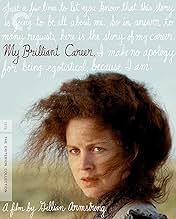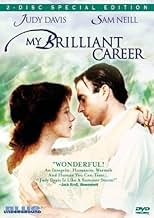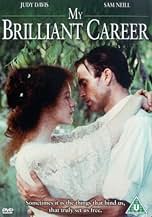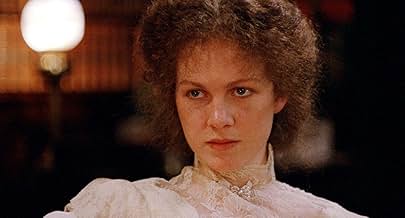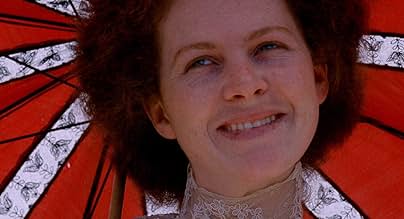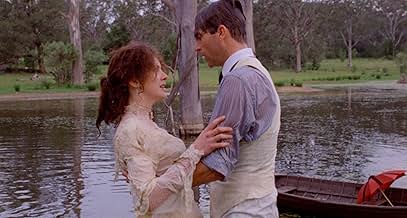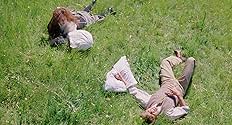ÉVALUATION IMDb
7,1/10
5,1 k
MA NOTE
Ajouter une intrigue dans votre langueA proud young woman in early 20th century Australia must choose between marriage and independence.A proud young woman in early 20th century Australia must choose between marriage and independence.A proud young woman in early 20th century Australia must choose between marriage and independence.
- Nommé pour 1 oscar
- 11 victoires et 8 nominations au total
Avis en vedette
Sometimes a life in film brings an experience like this. Its oddly tense in some dimensions and relaxed in others and the balance between the two seems distinctly Australian. I hadn't seen this when it was new, and I'm glad. Seeing a great film for the first time is a distinct pleasure.
I can think of only two similar pleasures in life.
Reviewers often focus on the story; its the common currency for discussion. The interesting fact behind the power of this movie is that the story is incoherent, poorly developed. There are a few main characters and none of them are attached to what are considered necessities for storytelling. They aren't introduced, we see them only through the effect of their presence. They don't develop. They influence nothing.
The main character is presented as a sort of Jane Austen both an Austen woman encouraged to marry, and Austen herself as a sort of author-in-her-own-book, like we saw in the 1999 film of Mansfield Park. But the odd thing is that we have Austen in Australia, the role and all the expectations without the baroque mechanics of society swirling around. Instead we get cows and sheep.
And emptiness, a cinematic vastness that even the US hasn't yet produced, despite Terence Malick.
So the incompleteness of the story is part of the genius of the thing. Our heroine doesn't have an Austenian future, instead becomes a backcountry Louisa May Alcott or George Sand. Indeed, Davis did go on to play Sand and Anderson went on to direct "Little Women." What our filmmaker has done is create a story where we subconsciously notice something is missing. And then she fills it with two things, this translucent actress and a similarly translucent open landscape.
First the landscape. Watch the opening of this. Its genius, shooting from outside in, peering in through windows and doors while we see literally the story beginning to be written. Then we shoot from the inside through the same windows out and see a dust tempest beginning.
This notion of space, inadequate enclosure, book and heroine conflated into them and weaving through them was copied after a fashion in the opening for the 2005 "Pride and Prejudice." Here, it is fresh, original, shocking. Effective, even life-affirming.
You can see a similar master vision in how the ending is shaped. We see our woman, a best friend by this time, going to mail her book to us. She approaches the fence and her dog scurries under, unconstrained by fences. Its a small thing, but by then we've become aware of how wonderfully our hidden woman behind the camera has shaped everything so minutely. That dog moves under the gate naturally, using a gait and hole that can only have come through hundreds of such exits. I have no idea how Anderson did it.
And now to Ms. Davis. Over time you pick things from the film vocabulary that you cleave to, things that naturally tip into the bucket of your soul. One of these for me is a certain type of folded acting I've noticed in Australian actresses. Blanchett, Winslet are the ones I follow deeply.
But you can see it here and I imagine that this is the first appearance of the style in a competent film. In my own historiography, Judy Davis invented it and does so here. If you watch her manner, you can see Cate. The style is what I call folded, where we get both the character and a higher level communication from the actor about the character.
We have a few folded actresses. What's even rarer is when the actress is intelligent and skilled enough to place that higher fold in the center of the filmmaker's intention. It happens here. Its beautiful, on a simpler level echoing the fact that we see a book, its making, and various considerations about the making of the book.
Because it is this sort of translucent folding, we see Cate when we see Judy.
You won't soon forget that.
I'm putting this on my list of films you really must see. Readers may be shocked. I only allow myself two from any given years and this year gave us "Alien," "Apocalypse Now," "Manhattan," and "Tree of Wooden Clogs," all of which are bumped by this. But this will change you, a female Herzog, unHerzog.
Now if I can only see "High Tide."
Ted's Evaluation -- 4 of 3: Every cineliterate person should experience this.
I can think of only two similar pleasures in life.
Reviewers often focus on the story; its the common currency for discussion. The interesting fact behind the power of this movie is that the story is incoherent, poorly developed. There are a few main characters and none of them are attached to what are considered necessities for storytelling. They aren't introduced, we see them only through the effect of their presence. They don't develop. They influence nothing.
The main character is presented as a sort of Jane Austen both an Austen woman encouraged to marry, and Austen herself as a sort of author-in-her-own-book, like we saw in the 1999 film of Mansfield Park. But the odd thing is that we have Austen in Australia, the role and all the expectations without the baroque mechanics of society swirling around. Instead we get cows and sheep.
And emptiness, a cinematic vastness that even the US hasn't yet produced, despite Terence Malick.
So the incompleteness of the story is part of the genius of the thing. Our heroine doesn't have an Austenian future, instead becomes a backcountry Louisa May Alcott or George Sand. Indeed, Davis did go on to play Sand and Anderson went on to direct "Little Women." What our filmmaker has done is create a story where we subconsciously notice something is missing. And then she fills it with two things, this translucent actress and a similarly translucent open landscape.
First the landscape. Watch the opening of this. Its genius, shooting from outside in, peering in through windows and doors while we see literally the story beginning to be written. Then we shoot from the inside through the same windows out and see a dust tempest beginning.
This notion of space, inadequate enclosure, book and heroine conflated into them and weaving through them was copied after a fashion in the opening for the 2005 "Pride and Prejudice." Here, it is fresh, original, shocking. Effective, even life-affirming.
You can see a similar master vision in how the ending is shaped. We see our woman, a best friend by this time, going to mail her book to us. She approaches the fence and her dog scurries under, unconstrained by fences. Its a small thing, but by then we've become aware of how wonderfully our hidden woman behind the camera has shaped everything so minutely. That dog moves under the gate naturally, using a gait and hole that can only have come through hundreds of such exits. I have no idea how Anderson did it.
And now to Ms. Davis. Over time you pick things from the film vocabulary that you cleave to, things that naturally tip into the bucket of your soul. One of these for me is a certain type of folded acting I've noticed in Australian actresses. Blanchett, Winslet are the ones I follow deeply.
But you can see it here and I imagine that this is the first appearance of the style in a competent film. In my own historiography, Judy Davis invented it and does so here. If you watch her manner, you can see Cate. The style is what I call folded, where we get both the character and a higher level communication from the actor about the character.
We have a few folded actresses. What's even rarer is when the actress is intelligent and skilled enough to place that higher fold in the center of the filmmaker's intention. It happens here. Its beautiful, on a simpler level echoing the fact that we see a book, its making, and various considerations about the making of the book.
Because it is this sort of translucent folding, we see Cate when we see Judy.
You won't soon forget that.
I'm putting this on my list of films you really must see. Readers may be shocked. I only allow myself two from any given years and this year gave us "Alien," "Apocalypse Now," "Manhattan," and "Tree of Wooden Clogs," all of which are bumped by this. But this will change you, a female Herzog, unHerzog.
Now if I can only see "High Tide."
Ted's Evaluation -- 4 of 3: Every cineliterate person should experience this.
It's 1897 rural Australia. It's rough living in a patriarchal society. Sybylla Melvyn (Judy Davis) has many big dreams. She wants a grand career rather than a marriage. Her mother tells her that they can't keep her anymore. She is sent away to live with her rich grandmother. She is excited at first by the change. She is soon pursued by the Frank Hawdon (Robert Grubb) and childhood acquaintance Harry Beecham (Sam Neill). She refuses to be married off. She grows closer and closer to Harry.
These are two great young Aussie actors. The story meanders a bit. My best comparison is Anne of Green Gables without the humor. Without the humor, Sybylla comes off a little more huffy. Judy Davis is a very appealing actress. The back and forth in the romance is quite compelling. It's an empowering story and there's also the acting. The cinematographer is also great.
These are two great young Aussie actors. The story meanders a bit. My best comparison is Anne of Green Gables without the humor. Without the humor, Sybylla comes off a little more huffy. Judy Davis is a very appealing actress. The back and forth in the romance is quite compelling. It's an empowering story and there's also the acting. The cinematographer is also great.
Don't get me wrong, I like Judy Davis & I like this movie because of the nice chemistry between her and Sam Neill. Sam sure was handsome when he was younger (still looks good now too, though).
In the end I didn't get the main character because her behavior didn't make a lot of sense to me. If Sam Neill's character was an idiot I would understand, but he was about as perfect for Davis' character as she could ever hope for & her "career" didn't seem like much of a lifestyle......so her actions left me perplexed.
Still, the movie was well done & the scenery was interesting. It kept me engaged until the end....however, when the final credits rolled I was left scratching my head.
In the end I didn't get the main character because her behavior didn't make a lot of sense to me. If Sam Neill's character was an idiot I would understand, but he was about as perfect for Davis' character as she could ever hope for & her "career" didn't seem like much of a lifestyle......so her actions left me perplexed.
Still, the movie was well done & the scenery was interesting. It kept me engaged until the end....however, when the final credits rolled I was left scratching my head.
Judy Davis is Sybylla, a girl of the Australian outback around 1909. As portrayed by Davis, in her breakthrough role, Sybylla is a font of boundless energy wanting desperately to escape the backwardness of her young life. Sam Neill, also in one of the significant early roles of his career, is likewise charming as the young man who presents her with a tempting alternative to her ambition to become a writer and escape the frontier life forever.
This is not a great or epic story, certainly, but it is a quiet, rewarding story of a young woman's quest for a better life. A worthy entry among the films that marked the ascendancy of the "Australian Renaissance" in film-making during the 1970s; director Armstrong would go on to make such films as "Mrs. Soffel" and the 1994 "Little Women."
This is not a great or epic story, certainly, but it is a quiet, rewarding story of a young woman's quest for a better life. A worthy entry among the films that marked the ascendancy of the "Australian Renaissance" in film-making during the 1970s; director Armstrong would go on to make such films as "Mrs. Soffel" and the 1994 "Little Women."
Judy Davis, as Sybylla Melvin, struggles with the conflicts that we all have between ambition, family, love, and guilt in a most remarkable manner. Sybylla grows to understand that life is a series of trade-offs, and that no one can have it all, and that no one can please everyone. Simple yet universal themes told with charm, wit, and a vulnerability that allows us to get right inside of her character and to understand her --- up to a point that is, a career is vital but I don't believe I'd have the strength to pass up Sam Neill under any circumstances, especially as cute as he is in this movie. In fact, all the acting is great, and the cinematography is breathtaking. Gillian Armstrong has been my idol ever since she made this magnificent film. I give it a 10.
Le saviez-vous
- AnecdotesJudy Davis learned the piano for her role in this film and played her own piano solos. Davis is credited for piano playing in the closing credits.
- Citations
[first lines]
Sybylla: Possum Gully, Australia. 1897. Dear fellow countrymen, just a few lines to let you know that this story is going to be all about me. So, in answer to many requests, here is the story of my career... here is the story, of my career... my *brilliant* career. I make no apology for being egotistical... because I am!
- ConnexionsFeatured in Ciné regards: Judy Davis (1980)
Meilleurs choix
Connectez-vous pour évaluer et surveiller les recommandations personnalisées
- How long is My Brilliant Career?Propulsé par Alexa
Détails
- Date de sortie
- Pays d’origine
- Langue
- Aussi connu sous le nom de
- My Brilliant Career
- Lieux de tournage
- sociétés de production
- Consultez plus de crédits d'entreprise sur IMDbPro
Box-office
- Budget
- 800 000 $ AU (estimation)
- Durée1 heure 40 minutes
- Mixage
- Rapport de forme
- 1.85 : 1
Contribuer à cette page
Suggérer une modification ou ajouter du contenu manquant

Lacune principale
By what name was Ma brillante carrière (1979) officially released in India in English?
Répondre

